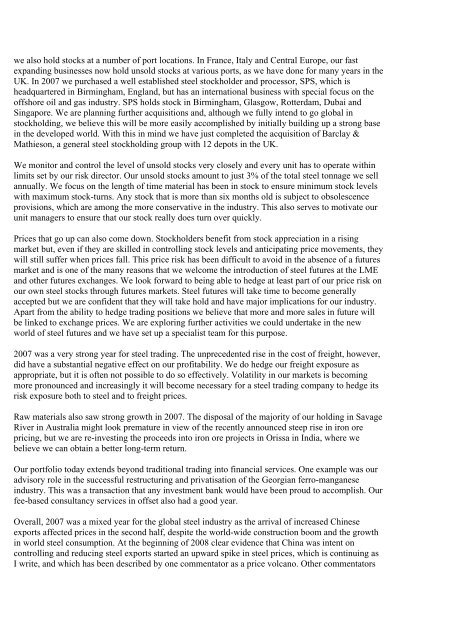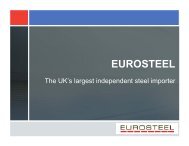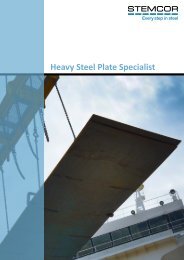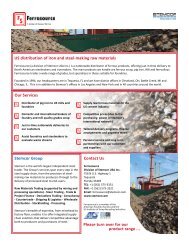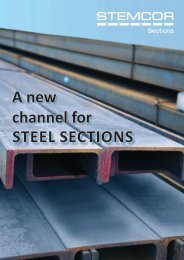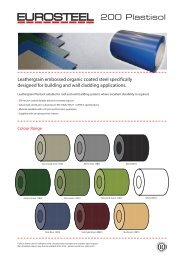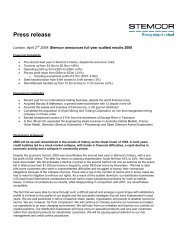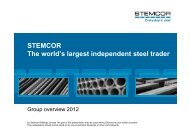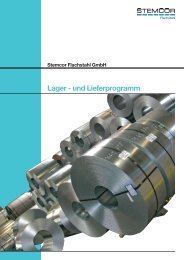You also want an ePaper? Increase the reach of your titles
YUMPU automatically turns print PDFs into web optimized ePapers that Google loves.
we also hold stocks at a number of port locations. In France, Italy and Central Europe, our fast<br />
expanding businesses now hold unsold stocks at various ports, as we have done for many years in the<br />
UK. In 2007 we purchased a well established steel stockholder and processor, SPS, which is<br />
headquartered in Birmingham, England, but has an international business with special focus on the<br />
offshore oil and gas industry. SPS holds stock in Birmingham, Glasgow, Rotterdam, Dubai and<br />
Singapore. We are planning further acquisitions and, although we fully intend to go global in<br />
stockholding, we believe this will be more easily accomplished by initially building up a strong base<br />
in the developed world. With this in mind we have just completed the acquisition of Barclay &<br />
Mathieson, a general steel stockholding group with 12 depots in the UK.<br />
We monitor and control the level of unsold stocks very closely and every unit has to operate within<br />
limits set by our risk director. Our unsold stocks amount to just 3% of the total steel tonnage we sell<br />
annually. We focus on the length of time material has been in stock to ensure minimum stock levels<br />
with maximum stock-turns. Any stock that is more than six months old is subject to obsolescence<br />
provisions, which are among the more conservative in the industry. This also serves to motivate our<br />
unit managers to ensure that our stock really does turn over quickly.<br />
Prices that go up can also come down. Stockholders benefit from stock appreciation in a rising<br />
market but, even if they are skilled in controlling stock levels and anticipating price movements, they<br />
will still suffer when prices fall. This price risk has been difficult to avoid in the absence of a futures<br />
market and is one of the many reasons that we welcome the introduction of steel futures at the LME<br />
and other futures exchanges. We look forward to being able to hedge at least part of our price risk on<br />
our own steel stocks through futures markets. Steel futures will take time to become generally<br />
accepted but we are confident that they will take hold and have major implications for our industry.<br />
Apart from the ability to hedge trading positions we believe that more and more sales in future will<br />
be linked to exchange prices. We are exploring further activities we could undertake in the new<br />
world of steel futures and we have set up a specialist team for this purpose.<br />
2007 was a very strong year for steel trading. The unprecedented rise in the cost of freight, however,<br />
did have a substantial negative effect on our profitability. We do hedge our freight exposure as<br />
appropriate, but it is often not possible to do so effectively. Volatility in our markets is becoming<br />
more pronounced and increasingly it will become necessary for a steel trading company to hedge its<br />
risk exposure both to steel and to freight prices.<br />
Raw materials also saw strong growth in 2007. The disposal of the majority of our holding in Savage<br />
River in Australia might look premature in view of the recently announced steep rise in iron ore<br />
pricing, but we are re-investing the proceeds into iron ore projects in Orissa in India, where we<br />
believe we can obtain a better long-term return.<br />
Our portfolio today extends beyond traditional trading into financial services. One example was our<br />
advisory role in the successful restructuring and privatisation of the Georgian ferro-manganese<br />
industry. This was a transaction that any investment bank would have been proud to accomplish. Our<br />
fee-based consultancy services in offset also had a good year.<br />
Overall, 2007 was a mixed year for the global steel industry as the arrival of increased Chinese<br />
exports affected prices in the second half, despite the world-wide construction boom and the growth<br />
in world steel consumption. At the beginning of 2008 clear evidence that China was intent on<br />
controlling and reducing steel exports started an upward spike in steel prices, which is continuing as<br />
I write, and which has been described by one commentator as a price volcano. Other commentators


